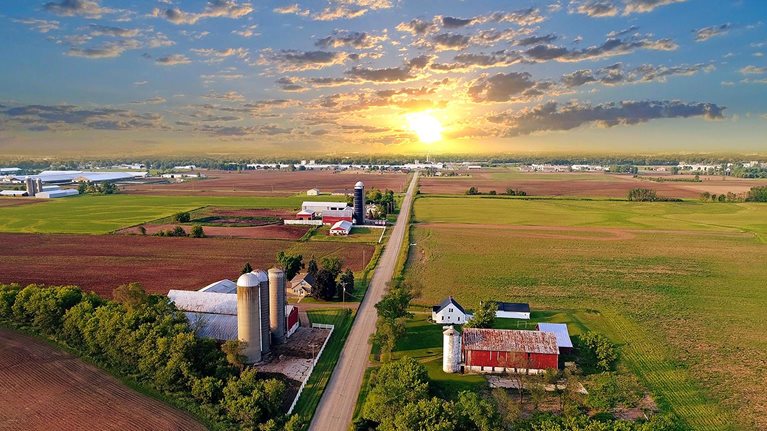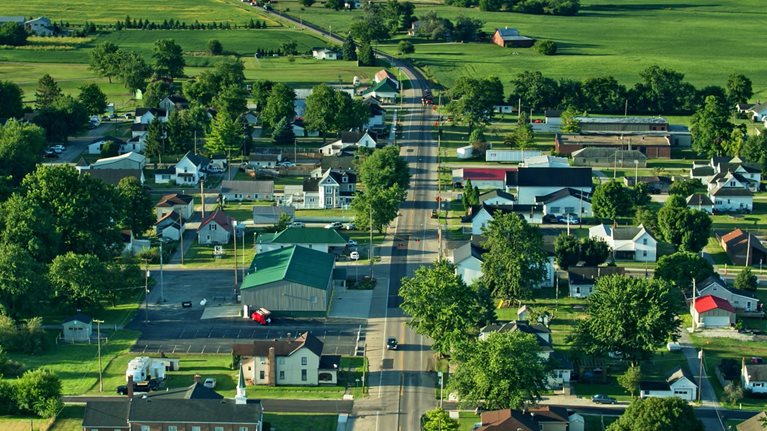The term ‘rural America’ often conjures a patchwork of shorthand phrases—“the heartland,” “small-town America,” “flyover country”—that attempt to encompass the vast expanse of communities outside the nation’s cities and suburbs. Yet these labels obscure more than they reveal. Rural America is not a monolith. It is home to one in seven Americans (approximately 46 million people in 2023) and encompasses a vast array of geographies, economies, and cultures.
Despite rural America’s scale and significance, it remains underresearched. To address this gap, in 2025, we established a dedicated focus area on rural communities within the McKinsey Institute for Economic Mobility.1 Our mission is to better understand the unique challenges and opportunities facing rural communities and develop actionable insights that can achieve meaningful results. Our first publication, in March 2025, examined the question, “Who is rural America?”2 Our analysis explored these communities and found them to be large, diverse, dynamic, and full of opportunity.
This report seeks to deepen our understanding of rural America and uncover insights from demographic and macroeconomic trends about barriers and opportunities for future growth. Using a data-driven approach, we defined six archetypes of rural communities in America, providing a framework for understanding the economic, social, and cultural dynamics that shape rural America today. We then delved into resident outcomes and well-being as well as trends in economic mobility across the rural archetypes. Our analysis highlights proven approaches to accelerate economic development in rural America along with actionable examples to improve economic mobility.
Together, these insights illuminate pathways to enhance resilience, growth, and opportunity across rural communities.
Defining the archetypes of rural America
To comprehend the evolving nature of rural America, we first explored the types of communities that make up these regions—their similarities as well as their differences. That analysis involved a statistical assessment of America’s more than 3,100 counties. We identified six archetypes of rural communities, which may help to better define what we mean when we talk about rural America (Exhibit 1).
While these archetypes share some features that define them as rural—such as population size and density and proximity to a metropolitan statistical area (MSA)—they are somewhat economically and socially distinct. Industry specialization varies greatly among rural archetypes (Exhibit 2). Dependence on these particular industries can make communities more vulnerable to macroeconomic shocks and fluctuations but also produce favorable economic outcomes for residents (see sidebar, “Industry concentration across rural and urban communities”).

The following in-depth profiles of the six archetypes feature representative counties across the United States and enable insightful comparisons among archetypes.
Agricultural powerhouses (7 percent share of total rural population)
These counties are home to small, moderate-growth communities with an agricultural focus (20 percent or more of GDP) and stable economy. Agricultural powerhouses, along with resource-rich regions, are sparsely populated—their share of rural counties is proportionally higher than their slice of the overall population. Agricultural powerhouses also have the highest labor force participation rate of all archetypes, at 59.8 percent.3
Within this archetype, there remain areas of variation. For example, a significant portion of agricultural powerhouses are built around larger-scale farms with a lower diversity of products such as corn, hogs, and dairy. These “commodity” counties create an outsize share of GDP ($47,000 in GDP per capita versus $22,000 for agricultural powerhouses) and see higher labor participation (63 percent compared with 55 percent).
Manufacturing workshops (26 percent share of total rural population)
In these midsize, growing communities, more than 30 percent of GDP comes from manufacturing. These regions are strengthened by higher-than-average labor participation and lower unemployment. While manufacturing workshops represent an outsize share of the rural population (approximately 26 percent), they account for a smaller share of counties (20 percent). Looking deeper, manufacturing workshops could be classified into two primary categories, each with its own attributes. Deindustrializing counties are concentrated in the Rust Belt, while reshoring counties are typically found in the South.
Migration magnets (25 percent share of total rural population)
These counties are midsize to large communities, often exurbs near metropolitan statistical areas (MSAs) or tourism hubs with consistently positive net in-migration. This archetype has two potential subarchetypes: counties near tourist destinations with largely hospitality-based economies (with average in-migration of 6 percent) and growing communities near MSAs (8 percent).
Remote regions (15 percent share of total rural population)
These counties are home to small and midsize communities with lower industrial specialization and economic output. In remote regions, factors such as larger net out-migration (greater than 4 percent), decreased labor force participation, and lower GDP contribute to slower growth and less industrial specialization than in other communities. These regions tend to be geographically isolated, and many have historical legacies of economic distress, such as the Mississippi Delta and the coal country of Appalachia.
Resource-rich regions (5 percent share of total rural population)
Resource-rich regions include small, remote communities where resource extraction (for example, mining, quarrying, and oil and gas) accounts for greater than 25 percent of GDP. These counties have experienced shrinking populations in the aggregate but generate twice the GDP per capita compared with agricultural powerhouses (ranked second on this metric). However, these regions saw their GDP decline by 6 percent from 2020 to 2022. Resource-rich regions, along with agricultural powerhouses, are sparsely populated—making up a higher share of rural counties than of overall population.
Middle America (22 percent share of total rural population)
Midsize or large communities that do not have major industry specializations or the defining characteristics of other archetypes are part of the middle America archetype. These counties have wide variation across economic characteristics and dimensions, but taken together, they currently experience better-than-average economic outcomes.
Measuring well-being and mobility in rural America’s archetypes
How are America’s rural residents doing across the archetypes? We assessed eight aspirations of well-being4:
- standard of living
- financial stability
- job opportunities with decent pay and good working conditions
- long, healthy lives
- opportunities to develop skills through affordable, quality education
- stable and secure homes
- physical and virtual connectivity
- stable communities
Using these eight aspirations, we calculated outcomes for residents in each of the six archetypes and then compared and ranked the archetypes (Exhibit 3).

Economic mobility, in this context, refers to the capacity of individuals to achieve improved economic outcomes relative to their parents. Specifically, this framework measures economic mobility by analyzing children's earnings distributions and other adult outcomes at age 35. We analyzed data from the Opportunity Atlas tool, which tracks economic mobility measures by county across the United States.5 This analysis identified counties and rural archetypes where children born into middle-income brackets (50th percentile) have the greatest potential for increasing their average income relative to their parents over time (Exhibit 4).

Middle-income residents in rural areas have achieved more stable economic mobility outcomes than urban counterparts, with more positive income growth across all six rural archetypes. Smaller manufacturing communities, particularly in the central US corridor, have elevated intergenerational mobility and income growth for workers without four-year degrees. With more than 70 percent of production and operative jobs classified as middle-wage jobs, investments in rural manufacturing could provide significant pathways to upward economic mobility.6
Exploring economic development strategies to improve well-being and mobility
Based on our review of rural America’s archetypes, the outcomes for residents, and our understanding of the drivers of economic impact, we identified six potential strategies for catalyzing rural economic development. We selected these strategies from a longer list of rural interventions based on two factors: proven impact and the ability to be replicated in other areas.
The selected economic development strategies primarily target underlying factors across three focus areas (Exhibit 5):
Businesses: Investing in the local institutions that drive economic activity
Workers: Tailoring workforce development to fit the specific needs of rural economies and fuel economic growth
Basic needs: Addressing the basic well-being of rural residents, especially for outcomes where rural areas lag furthest behind urban areas (such as health and life expectancy)
In addition, opportunities exist for holistic support across the cradle-to-career framework for the most distressed regions.

1. Stand up new partnerships supporting entrepreneurs and start-ups within specialized or high-growth industries
Rural counties often lack fast-growing industries, but many have specialized industry bases that can support high-growth small businesses. Despite a decline in rural entrepreneurship rates, organizations such as the Center on Rural Innovation (CORI) have helped communities design tech economy strategies, secure grants, and foster innovation. For example, CORI supported Independence, Oregon, in creating agtech coworking spaces and partnerships, driving economic growth. Similarly, the Critical Minerals and Materials for Advanced Energy (CM2AE) Tech Hub in Missouri harnesses the region’s mining expertise to create jobs and economic value. Rural archetypes with industry specialization, such as resource-rich regions, manufacturing workshops, and agricultural powerhouses, can see maximum impact from such initiatives.
2. Invest new capital in anchor institutions to support local business ecosystems
Anchor institutions such as universities and hospitals drive economic growth in rural areas by producing higher-skilled workers, attracting industries, and supporting knowledge creation and innovation. Counties near anchor institutions can maximize their impact through partnerships. For instance, Fresno State University’s Institute for Food and Agriculture has catalyzed Fresno County’s agricultural industry, attracting millions in grants and training local workforces. Similarly, Bucknell University’s Small Business Development Center supports entrepreneurship through workshops, consulting, and partnerships. This strategy is applicable to all rural counties that have a nearby anchor institution.
3. Prioritize postsecondary preparedness and connectivity for K–12 students
Rural counties face significant gaps in postsecondary attainment, limiting economic mobility. Programs such as Collegiate Edu-Nation (CEN) in Texas enable high school students to earn industry credentials and associate degrees, achieving high success rates. Similarly, the Rural Schools Innovation Zone (RSIZ) in Texas offers career academies in fields such as nursing and IT, helping students earn certifications for high-skill jobs. Building a postsecondary continuum is most influential in regions with low postsecondary attainment, such as remote areas, resource-rich regions, and manufacturing workshops.
4. Create rapid, targeted workforce training to support and attract growth industries
Rural areas with specialized industries such as agriculture, manufacturing, and mining need tailored workforce training to meet employment demands. Programs such as Georgia’s Quick Start and Alabama’s Industrial Development Training (AIDT) have successfully trained workers for high-skill roles, attracting significant investments and boosting local economies. For example, Quick Start partnered with South Korean battery maker SKBA to train employees for lithium-ion battery manufacturing, while AIDT supported Honda’s operations in Alabama. Workforce training programs are most effective in regions with high-growth industries requiring specialized skills, such as resource-rich regions, manufacturing workshops, and agricultural powerhouses.
5. Stand up rural-focused healthcare hubs to support resident well-being
Access to healthcare significantly affects economic outcomes, but rural areas often face shortages of providers and facilities. Telehealth hubs can address these challenges by offering remote care. For example, Project ECHO in New Mexico has expanded access to specialty care globally, while Sanford Health’s Virtual Care Initiative has established telehealth clinics in rural areas. These hubs have the greatest impact in regions with poor health outcomes and high uninsured rates, such as remote regions and manufacturing workshops.
6. Institute a set of complementary, place-based programs across the cradle-to-career framework
Distressed rural archetypes require comprehensive, place-based solutions to address systemic challenges. Backbone organizations such as Partners for Rural Impact (PRI) coordinate efforts across education, healthcare, and economic development. In Leslie County, Kentucky, PRI partnered with local health systems to provide transportation for dental care, funded by grants. Holistic solutions are particularly beneficial for remote and resource-rich regions, which face complex economic and social challenges.
While rural counties collectively contribute $2.2 trillion to the nation’s GDP, their economies are often characterized by specialized industries that tend to experience slower employment growth compared with urban areas. Unlocking the full potential of rural America will require targeted, evidence-based interventions.
Comprehensive, place-based solutions that address systemic barriers, such as investments in workforce training, healthcare access, and education, could play a pivotal role in reversing long-standing trends of economic stagnation. Without such interventions, the disparities between thriving and struggling rural communities are likely to widen, further exacerbating inequality and limiting economic mobility for millions of residents.
Rural America is not merely a peripheral part of the national economy but a critical contributor to its innovation and productivity. By applying these strategies with academic rigor and practical creativity, stakeholders have the opportunity to foster economic prosperity and improve well-being across the diverse communities that make up rural America.



